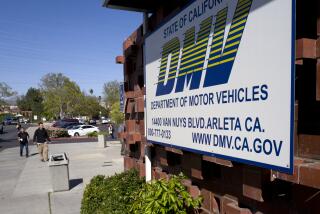Editorial: Putting ‘drivers’ in driverless cars is a smart safety measure
California may soon allow more autonomous vehicles to cruise the state’s roads — but only if the driverless cars have someone in the driver’s seat. So far, self-driving cars have been permitted on public streets only in tests using trained operators. The Department of Motor Vehicles released draft regulations this week that would allow manufacturers to lease the vehicles to the general public for everyday driving, provided that the “driver” is licensed, trained and sits behind the wheel, ready to take control in the case of emergency or malfunction.
[Google] argues that drivers and extra regulations aren’t needed as long as the vehicles follow the rules of the road and have a demonstrated record of safe driving.
Google, tech advocacy groups and even Lt. Gov. Gavin Newsom criticized the DMV as overcautious, saying the proposed regulations would stifle innovation and delay technology that could make the roads safer. Human error, after all, accounts for the vast majority of collisions. Autonomous vehicles use GPS and other navigation systems to get from point A to point B, and the cars rely on sensors and specialized software to react to situations on the road. Google designed its pod-like vehicles to be a completely driverless experience, although the developers added removable steering wheels and pedals during the testing phase. The company argues that drivers and extra regulations aren’t needed as long as the vehicles follow the rules of the road and have a demonstrated record of safe driving.
The new rules may indeed forestall the era of driverless cars, at least in this state, because they would reduce the technology’s appeal and utility. But the DMV is right to be cautious now, when both the technology and the human interaction with it are still new and untested on a mass scale.
The proposed regulations include safeguards that make sense for the initial rollout of driverless cars for the public. Carmakers would have to hire a third-party to validate the autonomous vehicle’s ability to perform in real-world driving conditions. Manufacturers would have to monitor their customers’ use of their cars and file monthly performance reports to the state. They would also have to train would-be drivers (or operators, as the DMV calls them) how to use the vehicles, and the state would have to certify that the training had been completed. The operator would be responsible for traffic violations, such as speeding, and the safe operation of the car — which means paying just as much attention to the road as if they were actually driving, and being ready to take the wheel at any time. Carmakers would be liable if the technology malfunctions or causes an accident.
These regulations should be viewed as a small, careful step toward the ultimate goal of getting fully autonomous vehicles on the road. If it’s a little slower than tech advocates want, that’s OK.
Follow the Opinion section on Twitter @latimesopinion and Facebook
More to Read
A cure for the common opinion
Get thought-provoking perspectives with our weekly newsletter.
You may occasionally receive promotional content from the Los Angeles Times.










